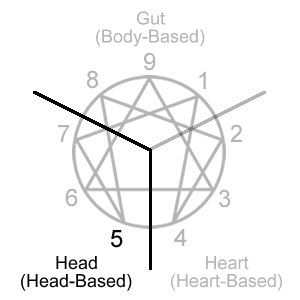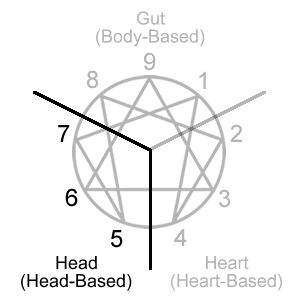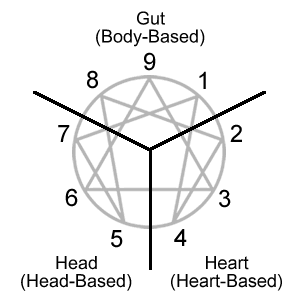Enneagram Type 5 Center: Head/Head-Based Type

The Head Center
Type 5 is located in the 567 triad which is often described as the head or head-based center.
-
Although the head types can be thought of in terms of reasoning, analyzing, and other typical thinking functions, a useful distinction from the other two centers can be made in terms of anticipating and preparing for future possibilities.
This may involve gathering data and facts in order to better predict outcomes, preparing for negative potentialities that might occur, and planning or pursuing activities that provide enjoyment and avoid discomfort.
Type 5 mentally observes and analyzes from the sidelines of a situation. It's an attempt to understand what's going on before stepping in and participating, having a mental map of sorts to navigate the situation. It not only minimizes effort by being more efficient when taking action but also creates a role for type 5 to play by having knowledge to draw from. This mental objectivity may also be used to detach from any emotions at hand that might otherwise be overwhelming.
Type 5 Fear
The fear triad consists of types 5, 6, and 7. Fear for these types involves the head center. It can be thought of as a negative anticipation of future possibilities and wanting to prepare for or avoid those possibilities.
This may involve learning as much as possible in order to feel competent and knowledgeable, imagining worst-case scenarios and preparing for them, and having alternatives available to avoid being trapped in discomfort or pain.
Type 5 fear is of being overwhelmed and not knowing enough to feel competent. They need time and space to process experiences. However, the world often doesn't allow for that. This can leave the type 5 feeling overwhelmed. Having the knowledge and competence beforehand eases that feeling.
Type 5 Mental Center
The core focus of the Enneagram types labels the 567 triad as the Mental Center to more clearly differentiate how those types use that center.
- Type 5: Mental Observation - observes the world by pulling back from it and watching.
- Type 6: Mental Questioning - probes to alleviate doubts and find what can be trusted.
- Type 7: Mental Possibility - avoids limitations while exploring interesting possibilities.
What Enneagram authors say about the head center

Below are samplings from some popular or well-known Enneagram authors. Click on the sources after the descriptions to further explore these interpretations.
-
The Thinking Triad1
Types Five, Six, and Seven are concerned with anxiety (they experience a lack of support and guidance). They engage in behaviors that they believe will enhance their safety and security. Underneath their ego defenses these types carry a great deal of fear. -
Mentally Based Intuition: Points Five-Six-Seven2
- Five - Detaching attention from thoughts and feelings in order to impartially observe. Mentally witnessing without interference from personal thoughts and feelings.
- Six - Seeing the unspoken intentions that lie beneath a surface facade. Using the imagination as a tool for unmasking hidden points of view.
- Seven - Knowing the fit between remote associations. A problem goes on the back burner of the mind while other activities continue. Something in a secondary task sparks an association that solves the original problem.
-
Head Center3
If you are a Head Center type (Five, Six, or Seven) you tend to filter the world through the mental faculties. The goals of this strategy are to minimize anxiety, to manage potentially painful situations, and to gain a sense of certainty through the mental processes of analyzing, envisioning, imagining, and planning. When threatened, fear and anxiety occur. -
The Fear or Head Triad (5, 6, 7)4
These numbers are driven by fear: Five externalizes it, Six forgets it, and Seven internalizes it. They take in and relate to the world through the mind. They tend to think and plan carefully before they act. -
The Head or Thinking Center (Fear)5
- Fives rely on their own resources and find safety in knowledge.
- Sixes seek relief from fear through the permission and approval of authority figures or through rebelling against authority.
- Sevens are active and optimistic. They shun unpleasant emotions, including fear.
-
The “head” center or “intellectual” center (Points 5, 6, and 7)6
regulates the thinking function: the experience and expression of thoughts, beliefs, and other cognitive activity. While essential for dispassionate analysis and reasoning, this form of intelligence can paralyze you if you get caught up in overanalyzing a situation.
Sources
1Book: The Wisdom of the Enneagram; Website: The Enneagram Institute
2Book: The Enneagram; Website: The Narrative Enneagram
3Book: The Essential Enneagram; Website: Dr. David Daniels
4Book: The Road Back to You
5Book: The Enneagram Made Easy
6Book: The Complete Enneagram; Website: Chestnut Paes Enneagram Academy
The Tri-Centers
The tri-center approach to the Enneagram types looks at an individual in terms of three types, one type from each of the three centers (i.e., gut, heart, and head). There may also be a preferred order to those three types (i.e., primary, secondary, and tertiary centers).
-
The Head Type
If your primary or basic Enneagram type is 5 then your primary center is the head center and type 5 is your head type.
The remaining two types in your tri-center will come from the other two centers.
The Gut Type
Your gut type will be type 8, 9, or 1.
There are several ways to interpret what the gut or body types represent. They may be thought of in terms of sensory-somatic (bodily felt sensation), sensory-motor (physical movement and activity), or instinctual (gut decision making).
This may involve taking action based on one's gut instinct, getting pulled along by the agenda of others, and actively trying to correct what's seen as wrong in the world.
The Heart Type
Your heart type will be type 2, 3, or 4.
The heart types are focused on interpreting, expressing, and reacting to one’s own emotions or the emotions of others. More specifically, the heart center focuses on what's emotionally significant in the sense that emotions are an indication of how strongly a person resonates with or against something or someone.
This may involve being attentive to the emotional needs and desires of others, seeking emotional affirmation for oneself from others, and expressing one's own unique emotional impression of the world.
-
Possible Tri-Centers for Type 5
5-8-2 5-2-8
5-8-3 5-3-8
5-8-4 5-4-8
5-9-2 5-2-9
5-9-3 5-3-9
5-9-4 5-4-9
5-1-2 5-2-1
5-1-3 5-3-1
5-1-4 5-4-1
Enneagram Tests to Help Determine Centers

The Enneagram personality types group the nine types into three centers of intelligence often referred to as the gut, heart, and head centers.
These tests help you find your dominant type in each center and the order of preference for those centers.
-
Dominant Type in Each Center with Wings Test
This test determines your dominant type in each center (aka tri-center, trifix, tritype, truetype) along with the wings of those types.
Use when you want to know your tri-center or tri-center with wings. -
Enneagram Type Preference Test
This test produces a scored list of all nine types.
Questions are forced-choice, similar to the method used by the Riso-Hudson Enneagram Type Indictor (RHETI).
Use to determine type, wings, gut/heart/head types, and tri-center. -
Center Type Comparison Test
This test scores the three types in a given center to determine your dominant type within that center (gut, heart, or head type).
Use when you don't know your dominant type for one of the centers. -
Type Comparison Test
This test compares any two types, producing a score for each.
Use when unsure of your tri-center order or which of two types is preferred for a center.
To learn more about Enneagram personality type 5 click here.
Click here for the Complete Guide to the Enneagram.
This free guide explains- the nine Enneagram personality types
- the many type variations within type
- where the types came from (origins and history)
- how the types use the Enneagram symbol
Click here for Enneagram tests.
These free tests help you find your- primary type
- candidate types
- preferred wing
- intinctual subtype
- instinctual variant stacking
- center types (gut, heart, and head)
- tri-center with wings